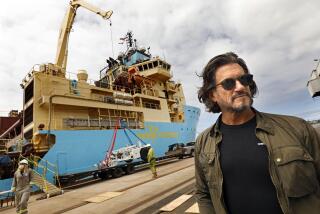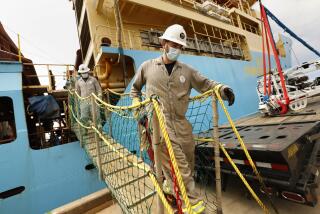Energy at Earth’s Center Supports Life on Sea Floor
- Share via
A deep-sea exploration 8,000 feet below the waves of the Pacific has confirmed what scientists only theorized just a few years ago--not all higher life forms rely on energy from the sun.
Marine scientists in an Alvin submersible--like the one used to explore the Titanic--found sea organisms that produce their own complex organic compounds, the crucial molecular building blocks that sustain life.
“Scientists once thought all animals were intimately linked to the surface,” said marine chemist Kenneth Johnson of the University of California, Santa Barbara.
“No one really felt that a chemically based community existed among higher life forms--everyone seemed to think of this great link to photosynthesis.”
Scientists thought the sun, by sparking the process of photosynthesis in green plants, produced the organic compounds--amino acids, sugars and carbohydrates--that virtually all higher life forms need to construct proteins.
Animals breathed the oxygenated air and ate plants or other animals that consumed plants--and the energy derived from photosynthesis was passed on.
But a nagging question remained, said Johnson, especially after thriving sea life was discovered by marine scientists in 1977 near the Galapagos Islands thousands of feet underwater in an area where biologists did not think higher life forms lived.
Can’t Work in Darkness
Photosynthesis cannot function in complete darkness, Johnson said.
So what did?
The chemist and his team of deep-sea explorers found communities of giant tube worms, mussels, clams and crabs that had a “symbiotic relationship with the bacteria” clustered around huge mineral-rich cracks on the ocean floor.
“These animals are living on the chemical energy from the center of the Earth,” he said.
The giant cracks, where water as hot as 782 degrees percolates through, are known as hydrothermal vents, and are sources of hydrogen sulfide, a chemical characterized by a rotten-egg smell.
The heat and a sulfur compound come from the hot magma in the Earth’s core.
The bacteria, Johnson found during a deep-sea chemical analysis with a special probe aboard the Alvin, combine the sulfide with oxygen in seawater to form sulfate, a process that releases energy to form the molecules needed to sustain life.
Apparently, the sea creatures are “inoculated with the bacteria in a way we don’t yet understand,” Johnson said. By way of this relationship, the animals can manufacture amino acids needed to construct proteins.
In a similar study at the Scripps Institute of Oceanography near San Diego, scientists have discovered that a certain kind of clam found in sulfide-rich habitats contain bacterial parasites in their gills.
Marine biologists Mark Powell and George Somero, writing in the journal Science, said the bacteria and the type of clam they studied required each other in order to live.
Somero plans to join Johnson and a group of French marine biologists next year to see if the chemical process on the surface is the same as that thousands of miles undersea.






